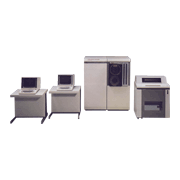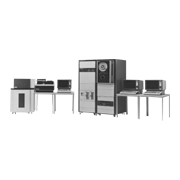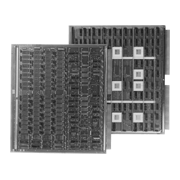This was a series of minicomputers from Mitsubishi Electric which ranged from the MELCOM70 Series Model 60 -- a super minicomputer with the highest performance among Japanese made machines, designed to meet demand for more sophisticated systems -- to the MELCOM70 Series Model L, a single board minicomputer containing a CPU on a single board, designed to meet demand for inexpensive components.
The Model 60 achieved improved CPU and input/output channel performance using features such as 32-bit memory read/write, 2-way memory interleave, a split-cycle memory bus, cache memory (8Kbyte, 150ns), a 32/64-bit arithmetic unit and 3 level pipeline control for instructions. There were two types of logical address, 16-bit and 23-bit, and dynamic address translation was done using, respectively, map address translation and table address translation. The system also had a comprehensive RAS design based on remote diagnosis as well as a full range of micro diagnosis functions employing a system control processor, 1-bit automatic error correction using ECC memory, and instruction retry, and also achieved improved operability through features such as remote startup and automatic operation capabilities for tasks like automatic power shutdown.
The Model L employed high-speed, high-integration MOS gate array LSI developed at the Mitsubishi Electric LSI Development Center, thereby allowing the CPU (including arithmetic processing unit, interrupt processing unit, memory control unit and input/output control unit) to be mounted on a single 310mm x 290mm board.
The Model 40 and Model 30 were mid-range minicomputers employing the technology of the Model 60.
The Model 10 was a Mitsubishi Electric component minicomputer employing Model L technology.
For the operating system, higher end models came with UOS (Universal Operating System), a 5-dimensional multiple processing operating system enabling real-time, time-sharing, transaction, batch and network processing in parallel. . Lower end models came with BDOS (Batch Disk Operating System) and RTMS (Real Time Operating System).
| Model 60 |
Model 40 |
Model 30 |
Model 10 |
Model L |
|||
|---|---|---|---|---|---|---|---|
| Announcement date | September 1978 | January 1979 | September 1978 | ||||
| Main memory | Word length | 32bit+ 7ECC bit |
16bit + 2 parity | ||||
| Cycle time | 600ns/4B | 550ns/2B | 600ns/2B | ||||
| Maximum memory capacity |
2MB | 512KB | 256KB | 128KB | |||
| Arithmetic control unit | Microprogram control system | 80bit horizontal | 48bit vertical | 24bit vertical | |||
| Addition/ Sub- traction time |
Fixed point | 0.25µs | 0.75µs | 4.6µs | |||
| Floating point | 1.5µs | 2.5µs | 12.4µs | 32.25µs | |||
| Address translation | Map/Table | Map | — | ||||




